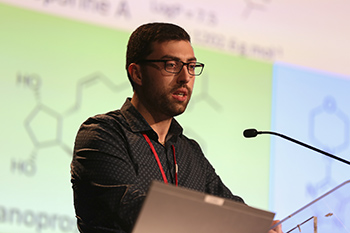Container-content interactions: ophthalmic drugs and multi dose flasks
6 October 2017
Y. Le Basle 1, Ph. Chennell2, V. Sautou2 1 CHU Clermont-Ferrand, Pôle Pharmacie, F-63000 Clermont-Ferrand, France2 Université Clermont Auvergne, CHU Clermont-Ferrand, CNRS, Sigma Clermont, ICCF, F-63000 Clermont-Ferrand, France

Conservative free ophthalmic formulations need to be packaged either as single doses, or using specially designed sterility preserving multi dose eyedroppers. Our objective was to evaluate potential content-container interactions between a device with a silicone sterility preserving membrane and the emitted drops of several ophthalmic solutions.
Latanoprost (0.05 mg/ml) and a micellar solution of cyclosporine (1, 10 and 20 mg/ml) were used as model drugs. Quantification of the active substance in emitted drops (1 to 2 drops per day) from low density polyethylene (LDPE) bottles without any sterility preserving device and from LDPE bottles with a sterility preserving silicone membrane (LDPE-Si) was performed for 14 days (n = 4), using validated HPLC methods.
For latanoprost, concentrations did not vary by more than 10% from the initial concentration in drops emitted from LDPE flasks. In LDPE-Si flasks, a decrease in latanoprost mean concentration was observed for every drop, throughout the 14 day study period, ranging from -22.9% in the first drop to -76.4% in the second drop and -64.9% at day 14. For cyclosporine, concentrations did not vary by more than 10% from the initial concentration in drops emitted from both LDPE and LDPE-Si bottles, for all 3 tested concentrations. However, for 1 mg/ml cyclosporine solutions, concentrations dropped by 7.3% in the third drop when emitted from LDPE-Si bottles, but quickly regained initial levels (-2.1%) thereafter.
LDPE-Si bottles should be avoided for the administration of the tested formulation of latanoprost, as the loss of active substance may cause a sever under-dosing. However, they may be used for tested formulation of ophthalmic cyclosporine. An evaluation of LDPE-Si bottles with other molecules (rifamycin, norfloxacin, timolol) is currently in underway.